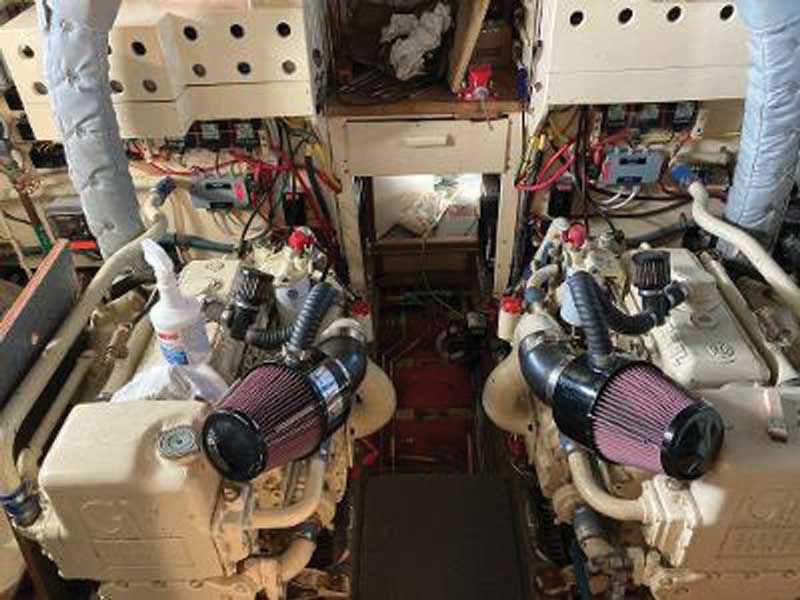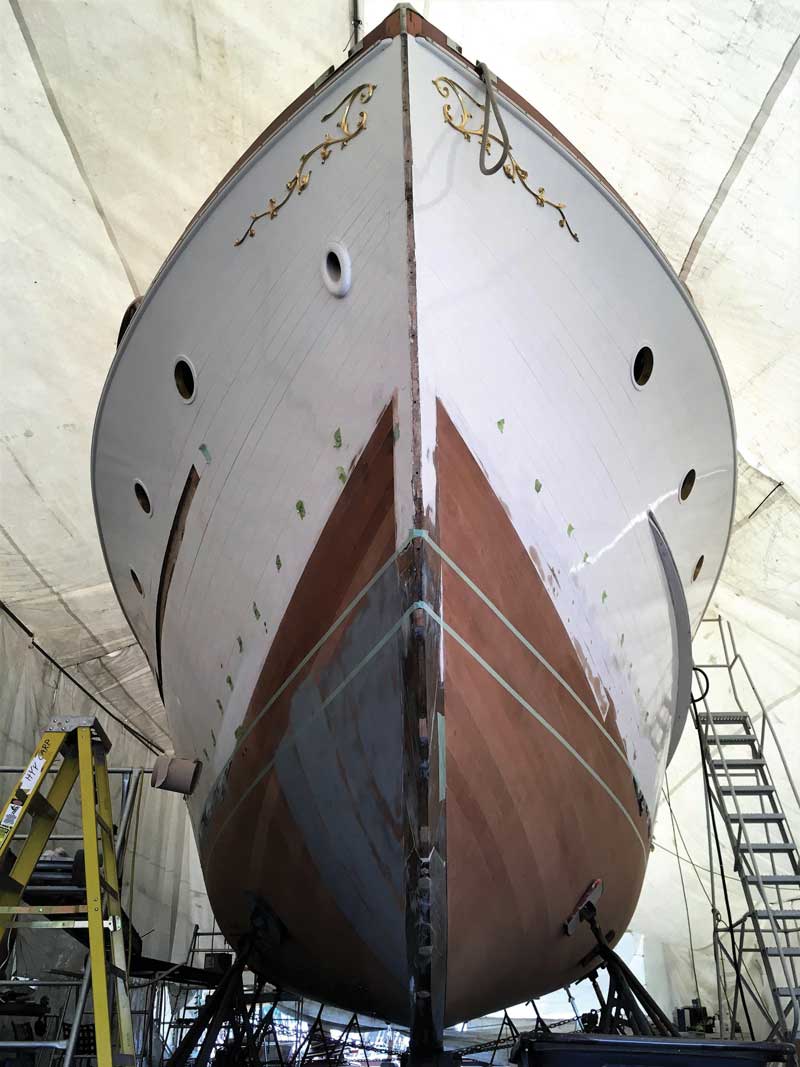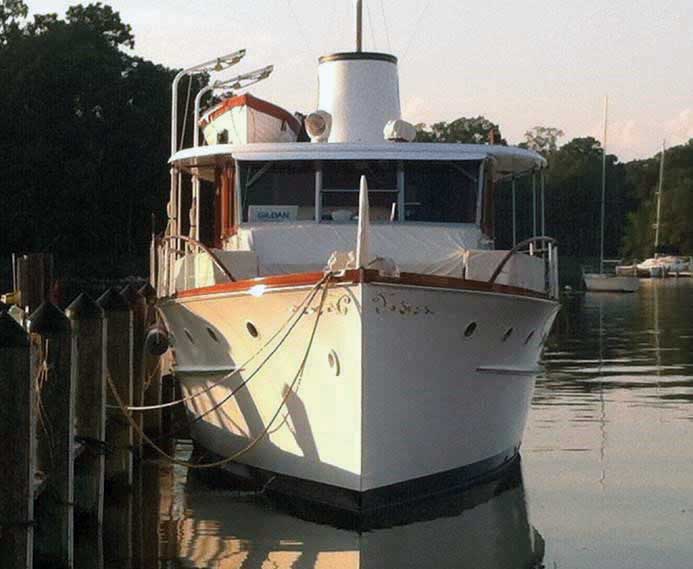Over the last few years, it seemed as if we had been receiving Boatshop Reports of work being done on a 55-foot 1950 Trumpy Yacht Houseboat named Manatee at Hartge Yacht Yard in Galesville, MD, for a long time, longer than one would expect, even for major maintenance.

With my curiosity aroused, I met with Alex Schlegel, owner and manager of the busy Galesville yard to get the story.
First, I asked him to clarify the use of the term houseboat since Trumpys don’t fit the modern concept of a houseboat at all.
“Trumpy called their designs with superstructure all above the deck and the wheelhouse forward a houseboat. Yachts built with a trunk cabin and the wheelhouse aft, they called a cruiser,” he explained. John Trumpy and Sons moved their wooden yacht building company to Annapolis in 1947. They closed in the early seventies rather than build in fiberglass. During that period they built what are arguably the world’s finest motor yachts.
I asked Alex to tell me some of Manatee’s story.
Many Years in the Yard
“The owner,” he answered, “who first brought the boat to us long ago, was in his 90s and had recently died and now his son has taken her over. The boat has been coming to our yard since some time in the 1970s when we had the railway at the other yard. She’d come every year, off and on, for maintenance since the owner preferred having her hauled on a railway. We did a lot on her over the years; part of the foredeck was bad, part of the front of the cabin. We worked on that one year; we did a lot of bits and pieces over the years. We might have put a new transom in it one year. I can’t even remember all that we’ve done on her.”

I asked why the boat seemed to be in the yard for so long this time.
“It was kind of a continuation of earlier work” he replied. “The aft end of the boat, the blocks for the struts and rudders, was going bad from electrolysis. You know how it turns mushy and yellow. That was fixed on the railway at Hartge Yacht Harbor. We were here, but we went over there to work on it. We fixed the back end, just where the problem was, new blocks and new planks. We put everything back together and then noticed that it needed more work than just there. They brought her over to us with the idea that the stringers that ran the length of the boat had steel bolts from the frames into the stringers and the bolts were going bad. Things in that area looked bad, so we started on that, thinking about three or four feet was all we’d need to do and then the owner said, ‘I think you ought to do the whole bottom,’” Alex laughed. “We started in the back where we’d fixed the problem,” Alex explained. “We started working our way forward and the more you looked the worse it got. Some frames were rotted and deteriorated. Some were broken and could be sistered and some needed replacement.”
In reply to my question about why the boat was wooded down and repainted in the water, Alex replied, “We left her in the water so she doesn’t dry out. We had her out of the water and in the tent for three years working on her bottom and she did dry out a bit, so with the paint job we did not want her to dry out again. After she came out of the tent, she left for the winter but has been back for a little more than a year, but we kept her in the water to get the work done.”

The Engine Room
But, after all, the heart of a motoryacht is the engine room. Alex recounted in detail how the Hartge Yard completely redid the engine room and major systems on the boat. “It has a fine engine room, good headroom, and access all around the two original Detroit 3-71 two-stroke diesels. The engine room entrance is through a full size oak panel door from the forward cabin. On a winter’s day it’s comfortable in the engine room, kept that way by engine block heaters. Sound and heat insulation is on the fore and aft bulkheads and on the overhead but not on the hull sides. The insulation is made by Soundown and constructed of a sheet of lead suspended in fiberglass batt and covered with a quilted grey fabric. The engines have dry exhausts that run straight up through the smoke stack. There is natural ventilation up the stack around the exhaust pipes. To help with ventilation when the engines are running, there are fans for intake air and exhaust air.
“Located on the starboard side forward bulkhead, is a custom engine instrument panel for the starboard engine. It is a circle of polished stainless steel mounted in a varnished mahogany frame. There is the autopilot drive, dual Parker Racor fuel filters/water separators for each engine, another set with a fuel pump to circulate the fuel through the fuel tanks, and a single filter for the generator. Each fuel filter set has a vacuum gauge to show if the filters are dirty. There are also two galvanic isolators for the two starboard 250-volt, 50-amp shore power inlets. The starboard hull side has two opening ports, discharge of four bilge pumps with anti-siphon valves, the starboard gyro stabilizer cooling water, and the starboard engine cooling water.

“The aft bulkhead is loaded with four 90-gallon fuel tanks, an air compressor and accumulator tank for the air horn, a group 31 start battery for each engine; one for the generator and two for the house with three combiners to tie all five batteries together. If a battery gets low, a combiner comes on automatically. If all the batteries in the engine room need help, a converter can be turned on to tie the 32-volt bank to the 12-volt batteries. The battery on/off switches and combiners can be controlled from the helm, and all can be monitored thru a NEMA system to the Garmin displays at the wheelhouse.
“There are refrigerator and freezer electronic switches to turn from normal water cooling to air cooling so they can be run when the raw water system is winterized, a work bench, a small door under the work bench for a second way out from below decks, just in case. Next are the refrigerator and freezer compressors, a 100-amp, 12-volt battery charger (there is a separate charger aft with the 32-volt battery system), and an oil change pump for the engines and generator.

“The portside of the engine room has an 11-kilowatt Westerbeke generator, two opening ports, raw water discharges for the generator, port engine, three bilge pumps and shower sump with anti-siphon valves, and a clothes washer. There is also the generator output breaker and two galvanic isolators for the two portside 250-volt, 50-amp shore power inlets. The portside forward bulkhead supports an Arid bilge pump with eight hoses to suck the last drop of water from the bilge, a 110-volt emergency bilge pump with three controls for separate sections of the bilge, each one divided to pump from both sides of the keel. Near the door are custom instrument panels for the generator and the port engine.
“Except for electronics and the aft head, there is only one thru hull below the waterline. It is for a raw water intake to a sea chest with valves for two engines, one generator, two Seakeeper gyro stabilizers, one air conditioner pump, and one refrigeration pump. All this is under the sole just forward of the engine room. The plumbing in the engine room has been rerouted for better bilge access and new floor boards are in place. On the overhead are cameras tied into the Garmin displays at the wheelhouse, to keep an eye on the engine room, 12-volt and 120-volt lights, and heat detectors. Most of the wiring is run in troughs for a neat appearance. Most plumbing, switches, electrical connector boxes, and valves are clearly labeled. With a couple of exceptions, like the engines and generator, we have installed all the equipment mentioned.”

After the new painting is done, Alex expects to return Manatee to her owner this August, but there is already talk of another project.
Trumpy Yachts take us back to an earlier era of slower paced, graceful elegance on the water. Whether that nostalgia is accurate or simply a reflection of modern discontents is hard to say. But, Manatee certainly is a thing of beauty and an appeal to the love of pretty boats hidden deep within all of us.
By Captain Rick Franke